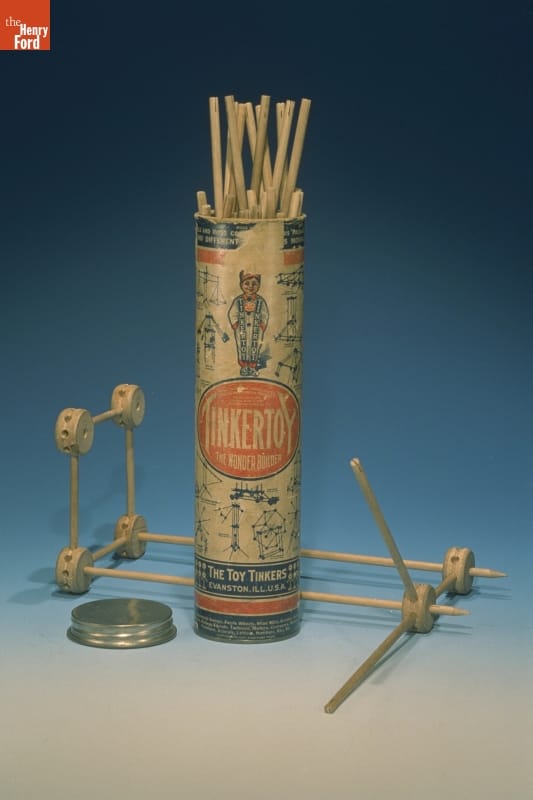Childhood Classics: The “Building Blocks” of Being a Kid

Recently, I stopped by the building block “wonderland” that is Towers of Tomorrow with LEGO® Bricks, a temporary exhibit in Henry Ford Museum of American Innovation.
I watched children (and also adults) busily absorbed in designing their own Lego creation - choosing from 200,000 Lego bricks placed within the exhibit as a hands-on activity for visitors. Some kids were likely inspired by the impressive Lego models of famous skyscrapers and other buildings displayed there. Many kids immediately dove into the “bottomless pit” of Lego bricks, jazzed by the opportunity to build something wonderful from their own imaginations.
And children DO love to build things--whether they create imaginary worlds or smaller versions of the real one. Construction toys are quite literally and figuratively “the building blocks of childhood.” Playing with them builds physical and intellectual skills--and encourages creativity. Toy bricks, logs and girders are the stuff of playtime joy!
Over the last 150 years, entrepreneurs have introduced innovative construction toys that have delighted generations of children. Which is your favorite?
District School Building Block Set, 1876-1886. THF300131. (Gift of Mrs. Clemens August Haass)
After the Civil War, the Charles M. Crandall Company’s building blocks were all the rage. Like Lego bricks, they could be easily and securely linked together in a “thousand and one” ways. By 1879, Crandall offered 28 sets of interlocking blocks and jointed figures.
This “District School” set was a miniature version of a common childhood experience of the era: the one-room rural school. Crandall advertised that children would “laugh over this group of teachers and scholars” as they built the school and arranged the figures. The “District School” had playful appeal, combining entertainment with education--children could learn their alphabet while having fun.
Tinkertoys, 1914-1925. THF97403
Tombstone cutter Charles Pajeau noticed how much fun his children had sticking pencils into empty thread spools and assembling them into imaginative forms. So, he designed a shorter wooden spool with one hole drilled in the center and a series of holes along the edge. Kids could now build at angles and connect multiple dowels at once. Tinkertoys were born! In 1914, Pajeau started a company to produce and market the toy.
Erector Set, 1915. THF95319
As toy marketer A.C. Gilbert rode the train from New Haven to New York on business, he watched as workers erected an electrical system along the railroad line using steel girders that had been riveted together. This inspired Gilbert to design a construction set for older boys with metal girders, panels, wheels, gears, and pulleys. His marketing spoke directly to boys, encouraging them to build.
Boys used their Erector sets to build small versions of steam engines, Ferris wheels, zeppelins, bridges, elevators, trucks, cranes, and other devices. The toy not only delighted boys--it also appealed to their parents, who appreciated the way Erector sets could introduce their kids to careers in engineering. The company even offered “degrees” from its “Engineering Institute.”
Lincoln Logs, about 1960. THF6627 (Gift of Steven K. Hamp)
John Lloyd Wright, son of architect Frank Lloyd Wright, invented Lincoln Logs. Introduced in 1916, these sturdy, miniature logs had interlocking notches. Lincoln Logs were named after Abraham Lincoln, who was born in a log cabin.
After World War II, Lincoln Logs got another boost as they became an iconic Baby Boomer toy. In the 1950s, nostalgia for the American West and the frontier had kids crafting log buildings with their Lincoln Log sets. With their nostalgic connection to America’s past, Lincoln Logs were marketed as “America’s national toy.”
Lego Building Set, 1976-1983. THF59
Legos, developed in Denmark during the 1950s, first appeared in the United States in 1962. With their small interlocking studs and tubes, Lego plastic bricks held together well - yet could easily be pulled apart. Lego bricks offered “no limits on what you can build.” Two Lego blocks could be joined in 24 different ways. Six blocks--over 100 million ways.
Lego bricks can be assembled and connected to create buildings, vehicles, and even human figures. Though the design and purposes of individual pieces have evolved over the years, each Lego brick--whether made in the 1950s or the present--remains compatible in some way with existing pieces.
Duplo bricks - larger sized versions made for preschoolers - debuted in 1969. They were easier for tiny hands to maneuver.
Over the years, Lego has created Lego sets with a variety of themes, including space, pirates, castles, robots, and the Wild West. They have licensed themes from popular cartoons, films, and video games--like Batman, Harry Potter, and Star Wars.
With their endless creative possibilities, Lego bricks have staying power--and fans worldwide. In 2000, Legos were named “Toy of the Century” by Fortune magazine and the British Association of Toy Retailers.
As a kid, I loved to design and build houses. Growing up, my siblings and I had Tinker Toys, Lincoln Logs, and an Erector set. I rather envied my friend--she had Block City, pre-Lego plastic bricks with architectural details like doors and windows (which Lincoln Logs lacked). My grandmother (who sewed a lot) kept a box full of empty spools and some wood scraps for us to build with--we created imaginary “towns” all over her living room floor. She never seemed to mind.
Jeanine Head Miller is Curator of Domestic Life at The Henry Ford.
Henry Ford Museum, making, LEGO, childhood, by Jeanine Head Miller, toys and games


Facebook Comments